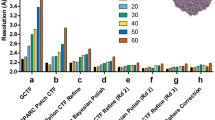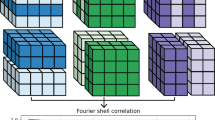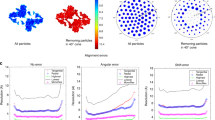Abstract
We propose two new measures of resolution anisotropy for cryogenic electron microscopy maps: Fourier shell occupancy (FSO), and the Bingham test (BT). FSO varies from 1 to 0, with 1 representing perfect isotropy, and lower values indicating increasing anisotropy. The threshold FSO = 0.5 occurs at Fourier shell correlation resolution. BT is a hypothesis test that complements the FSO to ensure the existence of anisotropy. FSO and BT allow visualization of resolution anisotropy. We illustrate their use with different experimental cryogenic electron microscopy maps.
Similar content being viewed by others
Main
Cryogenic electron microscopy (cryo-EM) aims to elucidate the structure of proteins and macromolecular complexes. Preferred orientation of the particles on the grid, or the subsequent image analysis, can cause the resolution of a Cryo-EM structure to be anisotropic1,2,3,4: such structures have a directionally variable signal-to-noise ratio5,6. The usual measures of resolution—Fourier shell correlation (FSC)-based global resolution7 and local resolution8—cannot assess anisotropy. Sphericity has been proposed as a measure of anisotropy1, but sphericity is difficult to interpret and does not indicate the range of spatial frequencies over which the reconstruction is anisotropic.
Here, we propose two new anisotropy metrics: the FSO, and a hypothesis test of anisotropy based on the classical BT in spherical statistics9. A practitioner can use their properties explained later to understand the quality of cryo-EM maps. Both metrics depend on the directional FSC of a structure, which is defined as follows: Let d be a direction (expressed as a unit length vector along a half-infinite ray from the origin), and let Cd be a solid cone with half-angle Ω and having d as its axis (Fig. 1a). Set D = S(ω) ∩ Cd, Then the directional FSC in S(ω), along the direction d is
where w(u) is a non-negative, continuous, real-valued ‘weight’ function satisfying ∫Dw(u)du = 1. We set the weight function to the normalized Gaussian function \(w({{{\bf{u}}}})=\frac{1}{C}{e}^{\frac{-{(\cos \theta -1)}^{2}}{{\sigma }^{2}}}\), where the constant C is determined by C = ∫Dw(u)du = 1, and θ is the angle between u and the cone axis d. The constant σ is the width of the Gaussian function and is set to \(\sigma =(1-\cos {{\Omega }})/2\) where Ω is the cone half-angle. This effectively reduces w to zero on the boundary of D. Signal-to-noise considerations suggest that a cone half-angle of 17° is optimal (Supplementary Information). This value is used in all numerical experiments below.
a, Scheme of directional FSC measurement. b, Description of the FSO curve. c–e, Apoferritin. f–h, Human CMG bound to AND-1. i–k, Influenza hemagglutinin trimer untilted map. l–n, Influenza hemagglutinin trimer tilted map. c,f,i,l, FSO (in continuous) and P value for the BT (dashed). d,g,j,m, Central slices along the X, Y and Z directions of the 3DFSC (FSC threshold of 0.143). e,h,k,n, DR as a function of the zenith and azimuth angles of the direction. a.u., arbitrary units.
The FSO in shell S(ω) is defined as the fractional volume of the shell where dFSC(ω, d) is greater than or equal to a threshold χ, which is nominally set to χ = 0.143.
where 1(. ) is the indicator function taking value 1 when dFSC(ω, d) > χ, and 0 otherwise.
The FSO has a number of interesting properties (Supplementary Information contains calculations and evaluations of these claims): FSO as a function of ω is approximately 1 for low frequency shells, and drops to 0 at high frequency shells (similar to the familiar FSC function), see Fig. 1b. In the range 0.9 < FSO(ω) ≤ 1, most directional FSCs are above the threshold χ, and the structure may be considered isotropic. In the range 0.1≤FSO(ω) ≤ 0.9 the fraction of directional FSC’s above the threshold χ begin to fall, and the reconstruction becomes increasingly anisotropic. This is the anisotropy transition zone. In addition to these properties, it turns out that FSO takes a value of 0.5 in the global resolution shell (see Supplementary Information for an explanation). Thus, the FSO provides an efficient summary of the reconstruction quality – it shows where the reconstruction is isotropic, where the reconstruction becomes anisotropic, and it also shows the global resolution, all in a single plot. When the structure is isotropic, FSO exhibits a step function-like behavior, which is the step occurring in the global resolution shell (see Supplementary Information for an explanation).
The FSO is a visual display of anisotropy. The BT complements this by providing a statistical measure (P value). In all our experiments FSO and BT are in agreement.
The (BT) is a precise hypothesis test of (an-)isotropy that we adopt from spherical statistics9 The classic BT for uniform distribution of points on a sphere in k − dimensions is as follows: The data are points (column vectors) xi, i = 1, ⋯ , N in a sphere in k − dimensions (that is xi is a k × 1 vector satisfying \({{{{\bf{x}}}}}_{i}^{T}{{{{\bf{x}}}}}_{i}=1\) for i = 1, ⋯ , N). From this data, we calculate the mean of the outer product \(T=\frac{1}{N}\mathop{\sum }\nolimits_{i = 1}^{N}{{{{\bf{x}}}}}_{i}{{{{\bf{x}}}}}_{i}^{T}\), which is a k × k matrix, and the statistic \(B=\frac{k(k+2)}{2}N(\,{{\mbox{tr}}}\,{T}^{2}-\frac{1}{k})\), where tr denotes the trace of a matrix. The theory of the BT9 shows that S has a \({\chi }_{(k-1)(k+2)/2}^{2}\) distribution, if the points xi are distributed uniformly on the sphere. Thus, evaluating the P value of B using a table of χ2 distribution, and comparing it to 0.05 evaluates whether the points are uniformly distributed on the sphere. If the P value is greater than the significance value (0.05), then the uniformity hypothesis is rejected.
We adapt the BT as follows: For every direction d in the Fourier shell S(ω) we calculate whether dFSC(ω, d) is greater than 0.143. All directions d for this is true are indicated as points xi on a unit sphere, the points being located at the intersection of the half-ray in direction d and the sphere. The B statistic is calculated for these xi using k = 3. If the p − value of the statistic is plotted as function of ω, then the range of ω where the p − value exceeds 0.05 is the range in which the reconstruction is anisotropic. Below, we show empirically that this range of ω’s is similar to the FSO transition zone.
Next, we demonstrate the use of FSO, and BT, to characterize Cryo-EM structures using gold-standard half-maps deposited in the EMDB. We also display the directional resolution (DR)1,3 and the three-dimensional FSC (3DFSC)1. These provide additional visualization of the anisotropy.
The first structure apoferritin EMDB-11638 (ref. 10) has octahedral symmetry, O, and a resolution of 1.22 Å (FSC at 0.143). This volume is highly isotropic, as the FSO and BT confirm (Fig. 1c). The sphericity of the map is 1. The 3DFSC for the map is uniform Fig. 1d. The resolution of the shell at which FSO = 0.5 is the global FSC resolution of the map. The FSO and the BT required 7 s of central processing unit (CPU) computation. Sphericity took 1 h 14 min for the CPU implementation and 3.81 min for the graphics processing unit (GPU) implementation.
The next structure is the human CMG bound to AND-1 (ref. 11) EMD-10621 (resolution 6.77 Å). The FSO (χ = 0.143; Fig. 1f) has an anisotropy transition region of (8.27, 5.08) Å. BT shows anisotropy in the range of (8.51, 4.37) Å. Further, FSO(ω) = 0.5 occurs at 6.8 Å, the global FSC resolution. Figure 1g,h shows the 3DFSC and the DR, the latter as a function of zenith and azimuth angles of the directions. Note the low resolutions around an azimuth angle of 225°, and the relatively higher resolutions around 90° and 270°. The sphericity of this map is 0.84 (ref. 1). The FSO, BT and resolution distribution took 10 s to compute on the CPU. Sphericity took 22.5 min for the CPU implementation and 99 s for the GPU implementation (https://github.com/nysbc/anisotropy/).
The influenza hemagglutinin trimer1 has preferred directions on the grid, which induce anisotropy. To reduce anisotropy, the original publication tilted the sample. As a consequence, there are two datasets: One with the sample untilted (EMPIAR-10097, resolution of 3.4 Å) and another with the sample tilted by 40° (EMPIAR-10097, resolution of 4.4 Å). The FSOs for both maps are in Fig. 1i (untilted) and Fig. 1l (tilted)). The transition zones are (4.77, 2.91) Å (untilted) and (5.73, 3.98] Å (tilted). BT shows anisotropy in (5.58, 2.84] Å (untilted) and (5.87, 3.98) Å (tilted). The sphericities are 0.84 (untilted) and 0.91 (tilted). All results show that tilting reduces anisotropy. The DR plots show the anisotropy, and its reduction with tilting (Fig. 1k,n). The resolutions of the shells at which FSO = 0.5 are 3.44 Å (untilted) and 4.27 Å, closely matching the global FSC. The computational times were 2 s for FSO and BT, and 47 min (untilted, CPU), 16.81 min (tilted, CPU), 2.45 min (untilted, GPU) and 1.03 min (tilted, GPU).
Finally, we visualized the difference between the original map and the anisotropy-eliminated map to understand how anisotropy manifested in the original map. All of the above maps were filtered at the anisotropy onset frequency, subtracted from the original map, and the absolute value of the result visualized (Fig. 2). Each column of Fig. 2 shows results for one map. The original maps are in the first row. The second row contains the filtered maps, and the third row contains the absolute value of the difference of the two. Directionally elongated blobs in the difference maps show the anisotropy in the original maps. This effect is especially strong in the untilted reconstruction of the influenza hemagglutinin (Fig. 2a). Higher magnification images of the difference maps are available in the Supplementary Information.
a–c, Original reconstruction (top), isotropic reconstruction obtained by low pass filtering at the resolution given by the threshold FSO = 0.9 (middle), absolute value of the difference of the two (down). a, Untilted reconstruction of the influenza hemagglutinin trimer. b, Tilted reconstruction of the influenza hemagglutinin trimer. c, Human CMG bound to AND-1.
An experimentalist can use FSO to understand how anisotropy affects the reconstruction at different resolutions. Changes in the anisotropy transition zone are especially useful to assess the effect of stage-tilting: Stage-tilting is not likely to be useful if most of the anisotropy reduction occurs in the low-resolution part.
Difference maps, such as those in Fig. 2, can be used to visualize anisotropic parts of reconstruction, and to assess whether a docked model (especially side chains) has directional support. In principle, it is also possible to compare a map with a model using FSO (Supplementary Information).
It is unclear whether anisotropy can be fixed computationally. Anisotropic filters, like a 3DFSC filter, cannot recover the missing directional information, but may be able to reduce anisotropic noise. Nonlinear sharpening algorithms, like DeepEMhancer12, may be able to improve or restore isotropy.
In conclusion, FSO and BT provide useful metrics for evaluating reconstruction anisotropy. We suggest using the endpoints of the anisotropy transition zone as numbers that summarize the map anisotropy.
Reporting summary
Further information on research design is available in the Nature Portfolio Reporting Summary linked to this article.
Data availability
The maps used in this work were taken from the Electron Microscopy Data Bank under accession codes EMD-11638 for the apoferritin; EMD-10621 for the human CMG bound to AND-1, and Electron Microscopy Public Image Archive under accession codes EMPIAR-10096 and EMPIAR-10097 for the influenza hemagglutinin trimer maps. Data used in the Supplementary Information are EMD-10659, EMD-2984, EMD-10691, EMD-22854, EMD-10525, EMD-22949, EMD-11220, EMD-22777 and EMD-22963.
Code availability
Our software can be found in GitHub (https://github.com/Vilax/FSO/), Xmipp13 (https://github.com/I2PC/xmipp/), Scipion 3.0 (ref. 14) (https://scipion.i2pc.es/) and the validation server15 (https://biocomp.cnb.csic.es/EMValidationService/).
References
Tan, Y. Z. et al. Addressing preferred specimen orientation in single-particle cryo-EM through tilting. Nat. Methods 14, 793–796 (2017).
Vilas, J. L., Tagare, H. D., Vargas, J., Carazo, J. M. & Sorzano, C. O. S. Measuring local-directional resolution and local anisotropy in cryo-EM maps. Nat. Commun. 11, 55 (2020).
Aiyer, S., Zhang, C., Baldwin, P. R. & Lyumkis, D. Evaluating local and directional resolution of Cryo-EM density maps. Methods Mol. Biol. 2215, 161–187 (2021).
Sorzano, C. O. S. et al. Algorithmic robustness to preferred orientations in single particle analysis by Cryo-EM. J. Struct. Biol. 213, 107695 (2021).
Penczek, P. A. Three-dimensional spectral signal-to-noise ratio for a class of reconstruction algorithms. J. Struct. Biol. 128, 34–46 (2002).
Penczek, P. A. Chapter three—resolution measures in molecular electron microscopy. Methods Enzymol. 482, 73–100 (2010).
Sorzano, C. O. S. et al. A review of resolution measures and related aspects in 3D electron microscopy. Prog. Biophys. Mol. Biol. 124, 1–30 (2017).
Vilas, J. L. et al. Local resolution estimates of cryo-EM reconstructions. Curr. Opin. Struct. Biol. 64, 74–78 (2020).
Mardia, K. V. & Jupp, P. E. Directional Statistics (Wiley, 1999).
Nakane, T. et al. Single-particle cryo-EM at atomic resolution. Nature 587, 152–156 (2020).
Rzechorzek, N. J., Hardwick, S. W., Jatikusumo, V. A., Chirgadze, D. Y. & Pellegrini, L. Cryo-EM structures of human CMG-ATPγS-DNA and CMG-AND-1 complexes. Nucleic Acids Res. 48, D1, 6980–6995 (2020).
Sanchez-Garcia, R., Gomez-Blanco, J., Cuervo, A., Sorzano, C. O. S. & Vargas, J. DeepEMhancer: a deep learning solution for cryo-EM volume post-processing. Commun. Biol. 4, 874 (2021).
de la Rosa-Trevín, J. M. et al. Xmipp 3.0: an improved software suite for image processing in electron microscopy. J. Struct. Biol. 184, 321–328 (2013).
de la Rosa-Trevin, J. M. et al. Scipion: a software framework toward integration, reproducibility, and validation in 3D electron microscopy. J. Struct. Biol. 195, 93–99 (2016).
Sorzano, C.O.S. et al. Image processing tools for the validation of Cryo-EM. Faraday Discuss. 240, 210–227 (2022).
Acknowledgements
This research was supported by the National Institutes of Health grant R01GM125769 (H.D.T.). We thank F. Sigworth for discussions. We dedicate this paper to the memory of M. C. Vilas-Diaz and D. M. Tagare, and M. D. Tagare who passed away during the coronavirus disease 2019 pandemic.
Author information
Authors and Affiliations
Contributions
The authors contributed equally to theory and experiments.
Corresponding authors
Ethics declarations
Competing interests
The authors declare no competing interests.
Peer review
Peer review information
Nature Methods thanks Philip Baldwin and the other, anonymous, reviewer(s) for their contribution to the peer review of this work. Primary Handling Editor: Arunima Singh, in collaboration with the Nature Methods team.
Additional information
Publisher’s note Springer Nature remains neutral with regard to jurisdictional claims in published maps and institutional affiliations.
Supplementary information
Supplementary Information
Supplementary material with sections and figures.
Rights and permissions
Springer Nature or its licensor (e.g. a society or other partner) holds exclusive rights to this article under a publishing agreement with the author(s) or other rightsholder(s); author self-archiving of the accepted manuscript version of this article is solely governed by the terms of such publishing agreement and applicable law.
About this article
Cite this article
Vilas, JL., Tagare, H.D. New measures of anisotropy of cryo-EM maps. Nat Methods 20, 1021–1024 (2023). https://doi.org/10.1038/s41592-023-01874-3
Received:
Accepted:
Published:
Issue Date:
DOI: https://doi.org/10.1038/s41592-023-01874-3
This article is cited by
-
The PfRCR complex bridges malaria parasite and erythrocyte during invasion
Nature (2024)
-
Quantitatively mapping local quality of super-resolution microscopy by rolling Fourier ring correlation
Light: Science & Applications (2023)





